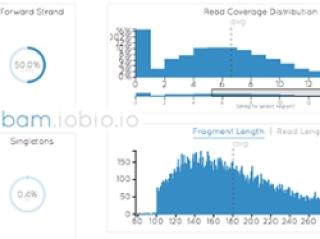Listen to Gabor Marth explain bam.iobio and its features on the Scope Radio.
(SALT LAKE CITY) - Bam.iobio is the first app of its kind that allows scientists to analyze genome sequence data on their web browser, interactively, and in real-time, without having to rely on terabytes of storage and vast sources of computing power. A publication describing the resource, developed by a team led by Gabor Marth, D.Sc., co-director of the USTAR Center for Genetic Discovery and human genetics professor at the University of Utah, appears online in the journal Nature Methods on Nov. 25.
The app analyzes BAM sequence alignment files, data generated from sequencing machines with detailed information on sequence quality and coverage. Ordinarily BAM interpretation takes hours or even longer to complete, and is encoded in an only machine-readable format. For the first time, bam.iobio puts this type of detailed inspection into the hands of the researcher. Data are expressed in a graphic interface that is easy-to-use and intuitive, enabling scientists to focus in on specific regions or genes of interest, if desired. The responsive format empowers the user to customize analysis parameters on the fly, returning query results in real-time.
"The ability to generate data on the scale of the entire genome at ever-decreasing costs has taken the community by surprise," says Marth. "We want to make this data really useful to the researchers. We're eliminating the need for expensive computational and hardware investments that before had limited this type of analysis to typically being done in institutional-scale data centers."
Bam.iobio will be the first of a series of apps to be developed using the powerful IOBIO "operating system". The second in the series, vcf.iobio, is also ready to use and enables scientists to analyze genomic variant report files – data on single nucleotide polymorphism and structural genetic variants - interactively, and in real-time. In the future, the team plans to develop apps for interactive, custom gene annotation, for examining local ancestry in a patient genome, and other interactive genome analyses. The next phase of the project, to occur within the next three months, will be a release of software libraries to developers so they can create their own apps based on the IOBIO platform.
Try bam.iobio: Go to http://bam.iobio.io, click "Choose Bam Url", and then "go" next to the default url.
Try vcf.iobio: Go to http://vcf.iobio.io, click on "Choose VCF Url", and then "go" next to the default url.
Main IOBIO project website: http://iobio.io.
Learn more about IOBIO by watching the video below.
# # #
Development of bam.iobio was supported by the National Human Genome Research Institute
"BAM.IOBIO: A web-based, real-time, interactive sequence alignment file inspector application", appearing online in Nature Methods on Nov. 25, was authored by Chase Miller, Yi Qiao, and Gabor Marth of the department of human genetics and USTAR Center for Genetic Discovery at the University of Utah, and Brian D'Astous formerly at Boston College, now at National Public Radio.
